Contents
Long Division
Introduction:
Long division is a mathematical algorithm that is used to divide large numbers or polynomials into smaller pieces. It is an important tool in mathematics, especially in arithmetic, algebra, and calculus. Method of dividing one number (dividend) by another number (the divisor) and finding quotient and remainder. Here, we will see long division, and how to do same, its importance in mathematics, fun facts about long division, long division tips and tricks, and some solved examples.
Looking to Learn Math? Book a Free Trial Lesson and match with top Math Tutors for concepts, homework help, and test prep.
Importance in Mathematics:
Long division is one of fundamental concepts in arithmetic, and it is used extensively in algebra and calculus. It helps us to understand principles of division, which is essential in solving mathematical problems. Long division is used in many areas of mathematics, including algebraic equations, quadratic equations, and calculus.
Parts of Long Division:
The long division has four main parts, which include:
Dividend: This number that is being divided. It larger number that is on the left side of division symbol.
Divisor: The number that is being used to divide dividends. It is a smaller number that is written on the right side of the division symbol.
Quotient: This result of division. It is the answer that is obtained after dividing the dividend by the divisor.
Remainder: This amount is left after the division is complete. It is the difference between the dividend and product of divisor and quotient.
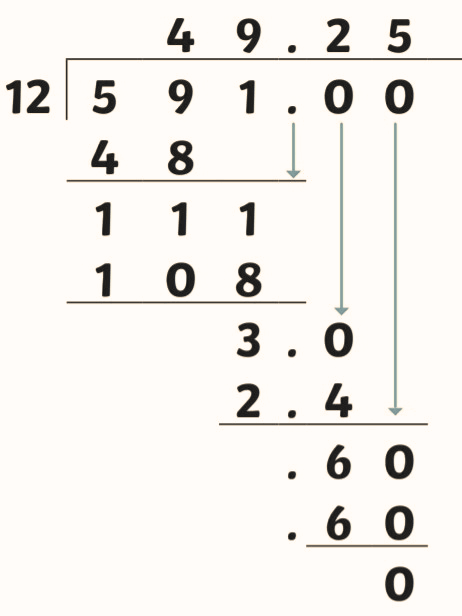
Symbol of Division:
The symbol of division is a horizontal line with a dot above and a dot below (\[ \div \]). Dots indicate that division is taking place. The dividend is written above the division line and the divisor is below the division line. The quotient is written on the right side of the division symbol, and the remainder is above the division symbol.
The symbol of division is significant in the process because it separates the dividend from the divisor and indicates the operation that is being performed. It also helps to maintain the order of numbers during the division process.
Process of Long Division:
Long division is a step-by-step process that involves several steps. The following are steps involved in long division:
- You have to write dividend on left hand side of division symbol.
- You have to write divisor on right hand side of division symbol.
- Find out how many times divisor will go into first digit of dividend. Then you to write number above first digit of dividend.
- Then you have to multiply divisor by number just wrote and write its product under first digit of dividend.
- Then you have to Subtract product from first digit of dividend.
- Bring down next digit of dividend and write it next to remainder.
- Do steps 3-6 again until we have divided all digits of dividend.
- Write its remainder
Example:
\[\,645 \div 3\]
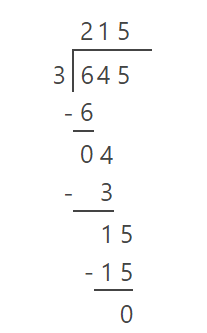
Long Division Steps:
Following are steps involved in long division, broken down further for clarity:
- First you have to divide first digit of dividend by divisor.
- Then write its quotient above dividend.
- Then multiply its quotient by divisor and write product below dividend.
- Then you have to Subtract its product from first digit of dividend.
- Then bring down next digit of dividend and then write next to remainder.
- Do steps 1-5 again until we have divided all digits of dividend.
- Write its remainder
Division with Remainders:
There are two cases of division with remainders:
Case 1: When the dividend’s first digit is equal to or greater than the divisor. For this case, after subtracting the product from the dividend’s first digit, bring down the dividend’s next digit and do it again. When the remainder is less than the divisor, stop there and write the remainder
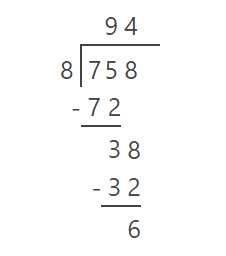
Case 2: When the dividend’s first digit is less than the divisor.
In this case, take the dividend’s second digit and write its quotient above the dividend.
After that multiply the quotient by the divisor and write its product below the dividend.
Then do again until the remainder is less than the divisor. Write its remainder
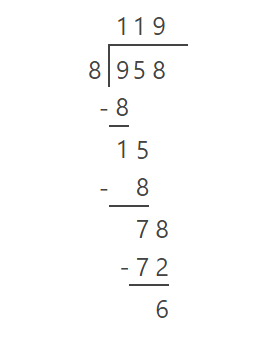
Division without Remainder:
If the dividend is exactly divisible by the divisor, then the remainder will be zero. In this case, simply write quotient as the result of division.
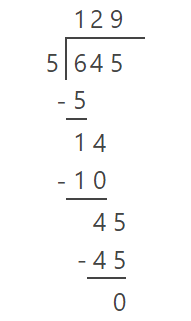
Long Division of Polynomials:
Long division can also be used to divide polynomials. Steps involved in the long division of polynomials are similar to steps involved in the long division of numbers. Dividend is written as a polynomial, and divisor is also written as a polynomial. The process of long division is then followed, with coefficients of polynomials being divided in place of digits of dividend.
Long Division with Decimals:
Long division can also be used to divide decimals. The process is similar to the long division of numbers, but the decimal point must be considered. The decimal point is placed directly above the division symbol, and the process is carried out as usual.
Fun Facts about Long Division:
- Long division was first introduced in Europe in 13th century.
- Long division algorithm has remained virtually unchanged for over 500 years.
- Longest division ever computed by a human was done by Shakuntala Devi, an Indian mathematician, who calculated division of two 13-digit numbers in 28 seconds.
- Long division is often used as a form of mental math, with some people being able to perform it quickly and accurately in their heads.
- Long division is considered one of most challenging topics in mathematics for students to learn.
When Children Learn About Long Division in School:
Children typically learn about long division in 4th or 5th grade, depending on the curriculum of their school district. Some schools may introduce long division earlier, while others may wait until later.
Long division is usually introduced after children have mastered basic addition, subtraction, multiplication, and division. It is an essential tool for understanding more complex mathematical concepts.
How Long Division Relates to Other Areas of Mathematics:
Long division is a fundamental concept in mathematics and is used extensively in many areas, including algebra, calculus, and statistics. It is essential for solving equations and understanding mathematical relationships. Long division is also important in everyday life, as it is used for calculating taxes, budgets, and other financial calculations.
Long Division Tips and Tricks:
- Practice, practice, practice. More practice long division, easier it will become.
- Use graph paper or lined paper to keep numbers aligned and make it easier to keep track of work.
- Use estimation to check answers. If estimate is close to actual answer, then division is done correctly.
- Use mnemonics or memory aids to help remember steps involved in long division.
- Double-check calculations and make sure to have not made any mistakes.
Common Mistakes When Doing Long Division and How to Avoid Them:
- Forgetting to carry over a remainder to next step.
- Misaligning numbers, which can lead to incorrect calculations.
- Failing to estimate quotient or remainder, which can result in incorrect answers.
- Not checking work, which can result in mistakes going unnoticed.
- To avoid these mistakes, it is important to take time and be precise when performing long division.
- Use graph paper or lined paper to keep numbers aligned, and double-check calculations to make sure have not made any errors. It is also a good idea to estimate quotient or remainder to check work and catch any mistakes before they become a problem.
Conclusion:
In conclusion, long division is an important mathematical concept that is used in many areas of mathematics and everyday life. It is a fundamental tool for solving equations, understanding mathematical relationships, and making financial calculations. Children typically learn about long division in 4th or 5th grade, and it is important to practice regularly and use mnemonics or memory aids to help remember the steps involved. By taking time, being precise, and checking work, can avoid common mistakes and become proficient in long division.
Solved Examples:
1. Divide \[156 \div 6\]using long division.
Ans:
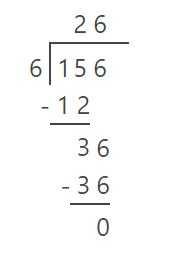
The quotient is 26, and there is no remainder.
2. Divide \[359 \div 9\] using long division.
Ans:
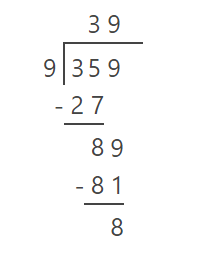
The quotient is 39, and the remainder is 8
3. Divide \[648 \div 3\] using long division.
Ans:
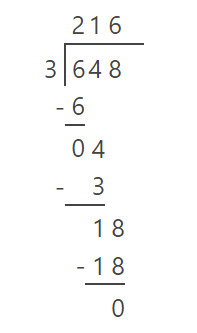
The quotient is 216, and there is no remainder.
4. Divide: \[2387 \div 43\]using long division.
Ans:
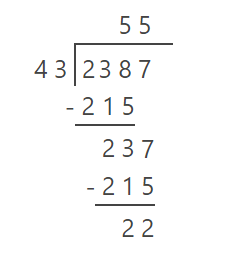
The quotient is 55, and the remainder is 22
5. Divide 67 by 8 using long division.
Ans:
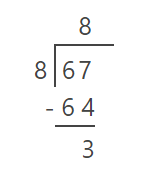
The quotient is 8, and the remainder is 3.
Looking to Learn Math? Book a Free Trial Lesson and match with top Math Tutors for concepts, homework help, and test prep.
FAQs:
1. What is the long division method?
Ans: The long division method is a process of dividing one number by another using repeated subtraction and multiplication to determine the quotient and remainder.
2. Why is long division important in mathematics?
Ans: Long division is important in mathematics because it is a fundamental tool for solving equations, understanding mathematical relationships, and making financial calculations.
3. How to divide using long division?
Ans: To divide using long division, first write dividend (the number being divided) and divisor (number doing dividing) in a long division bracket. Then, divide the first digit of the dividend by the divisor and write the quotient (answer to division) above the dividend. Next, multiply the quotient by the divisor and write the product (the result of multiplication) underneath the part of the dividend just divided. Subtract the product from part of the dividend just divided, and bring down the next digit of the dividend. Repeat this process until have no more digits to bring down, and the remainder (if any) is the final answer.
4. How can I avoid common mistakes when doing long division?
Ans: To avoid common mistakes when doing long division, it is important to take time, be precise, use graph paper or lined paper to keep numbers aligned and double-check calculations.
5. Can a long division be used to divide decimals?
Ans: Yes, long division can be used to divide decimals. The process is similar to the long division of numbers, but the decimal point must be considered.
References:
https://www.math-only-math.com/long-division.html
R.S.Agarwal maths book

Written by
Prerit Jain
